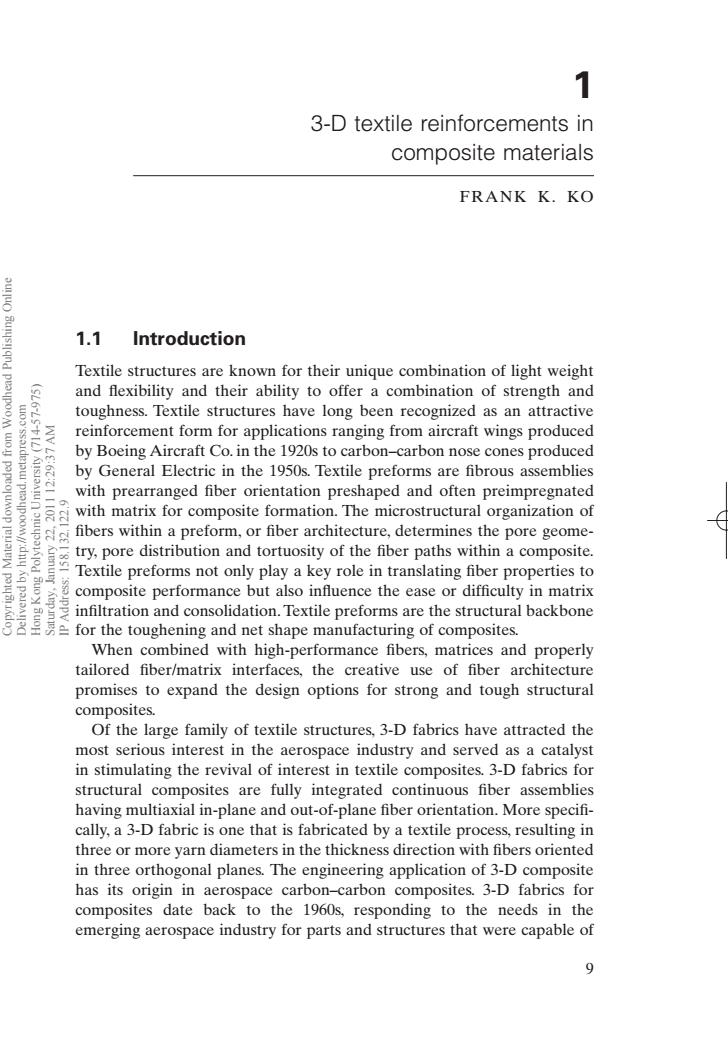正在加载图片...

1 3-D textile reinforcements in composite materials FRANK K.KO 1.1 Introduction Textile structures are known for their unique combination of light weight and flexibility and their ability to offer a combination of strength and toughness.Textile structures have long been recognized as an attractive reinforcement form for applications ranging from aircraft wings produced by Boeing Aircraft Co.in the 1920s to carbon-carbon nose cones produced by General Electric in the 1950s.Textile preforms are fibrous assemblies with prearranged fiber orientation preshaped and often preimpregnated with matrix for composite formation.The microstructural organization fibers within a preform,or fiber architecture,determines the pore geome- try,pore distribution and tortuosity of the fiber paths within a composite. Textile preforms not only play a key role in translating fiber properties to 、兰 composite performance but also influence the ease or difficulty in matrix infiltration and consolidation.Textile preforms are the structural backbone for the toughening and net shape manufacturing of composites When combined with high-performance fibers,matrices and properly tailored fiber/matrix interfaces,the creative use of fiber architecture promises to expand the design options for strong and tough structural composites. Of the large family of textile structures,3-D fabrics have attracted the most serious interest in the aerospace industry and served as a catalyst in stimulating the revival of interest in textile composites.3-D fabrics for structural composites are fully integrated continuous fiber assemblies having multiaxial in-plane and out-of-plane fiber orientation.More specifi- cally,a 3-D fabric is one that is fabricated by a textile process,resulting in three or more yarn diameters in the thickness direction with fibers oriented in three orthogonal planes.The engineering application of 3-D composite has its origin in aerospace carbon-carbon composites.3-D fabrics for composites date back to the 1960s,responding to the needs in the emerging aerospace industry for parts and structures that were capable of 91.1 Introduction Textile structures are known for their unique combination of light weight and flexibility and their ability to offer a combination of strength and toughness. Textile structures have long been recognized as an attractive reinforcement form for applications ranging from aircraft wings produced by Boeing Aircraft Co. in the 1920s to carbon–carbon nose cones produced by General Electric in the 1950s. Textile preforms are fibrous assemblies with prearranged fiber orientation preshaped and often preimpregnated with matrix for composite formation. The microstructural organization of fibers within a preform, or fiber architecture, determines the pore geometry, pore distribution and tortuosity of the fiber paths within a composite. Textile preforms not only play a key role in translating fiber properties to composite performance but also influence the ease or difficulty in matrix infiltration and consolidation. Textile preforms are the structural backbone for the toughening and net shape manufacturing of composites. When combined with high-performance fibers, matrices and properly tailored fiber/matrix interfaces, the creative use of fiber architecture promises to expand the design options for strong and tough structural composites. Of the large family of textile structures, 3-D fabrics have attracted the most serious interest in the aerospace industry and served as a catalyst in stimulating the revival of interest in textile composites. 3-D fabrics for structural composites are fully integrated continuous fiber assemblies having multiaxial in-plane and out-of-plane fiber orientation. More specifi- cally, a 3-D fabric is one that is fabricated by a textile process, resulting in three or more yarn diameters in the thickness direction with fibers oriented in three orthogonal planes. The engineering application of 3-D composite has its origin in aerospace carbon–carbon composites. 3-D fabrics for composites date back to the 1960s, responding to the needs in the emerging aerospace industry for parts and structures that were capable of 1 3-D textile reinforcements in composite materials FRANK K. KO 9 RIC1 7/10/99 7:15 PM Page 9 Copyrighted Material downloaded from Woodhead Publishing Online Delivered by http://woodhead.metapress.com Hong Kong Polytechnic University (714-57-975) Saturday, January 22, 2011 12:29:37 AM IP Address: 158.132.122.9